[Post originally published on substack on July 25, 2023.]
A tall body is the ultimate weapon in basketball… or maybe not? Aoba Taiju is roughly 2m (~6.6ft) tall. He has played basketball since primary school, and yet, his worth as a player is constantly being contested. Not because of a lack of experience or some other skill-related issue. No, purely because of his height. Wait! Don’t let the confusion overcome you yet! Once you start reading Aoba no Basuke (Aoba’s game of basketball) and follow him and his teammates as they prove their worth as athletes, you’ll see that there’s more to basketball than the players’ height. [Post based on Volume 1 & 2]
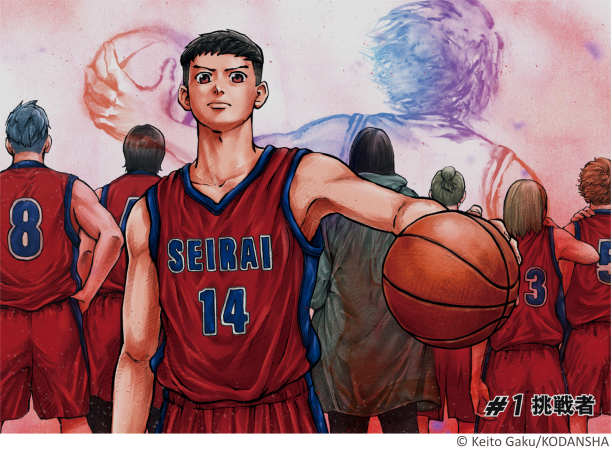
A Disadvantageous Advantage
“ ‘Japanese, with their inferior physique, aren’t cut out to play basketball.’ ‘They won’t succeed on the world stage.’ Such things were whispered with every defeat. However, the issue now is not ‘size’!! So, what is it, then?”
Intrigued by these opening lines, I couldn’t wait to immerse myself in this story. I swiped the digital page and was first greeted by Aoba Taiju, the manga’s protagonist. Standing in the middle of the two-page color spread, ball in hand, he stared challengingly down at me, as if to dare me to question the previous statement. I must admit, I did raise an eyebrow when I read that size doesn’t matter in basketball. Trying to avoid Aoba’s gaze, I thought of professional players who can reach the hoop at a height of 3.05m (10ft) with a small skip to let the ball slide effortlessly into the basket. Also, when I occasionally played basketball as a hobby, I experienced the towering barrier a 2-meter player can present. So, I couldn’t rid myself of the feeling that size is important in this game.
Additionally, the manga is about a 2-meterish (~ 6.6ft) young basketball player. Why question the benefit of the protagonist’s main asset right from the start? Naturally, I was curious about how the mangaka, Gaku Keito (Boys Run the Riot), was going to develop the story. In particular, what he was going to tell us readers about ‘size.’ And he begins by conveying the drawbacks of bodily height through Aoba’s disheartening experiences during his elementary school days.
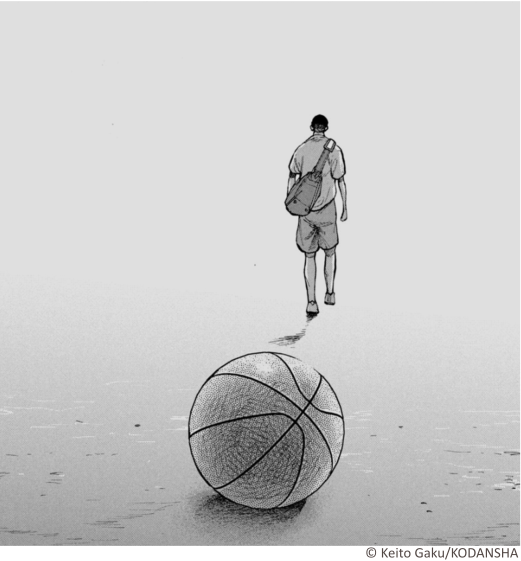
Contrary to what one might assume, Aoba’s size, even at this young age, proved to be a disadvantage in basketball. Not for the game as such, but his ‘unlawful’ height caused resentment and anger among the other boys and particularly their parents. Aoba’s quality as a player was quickly reduced to his stature, and the trainer was accused of playing favorites because of the boy’s height. Thus, Aoba concluded that with him as an active player, the others wouldn’t be able to enjoy the game anymore, so he gave up on the sport. Until, one year later in middle school, he was sought out by an athlete who was just as tall as him: the U16 national team player, Akehoshi Reo.
Challenging Height
Akehoshi, the cheerful and energetic third-year, happened to go to the same middle school as Aoba. He was looking for new members for the school’s basketball club and had his eyes set on the tall and athletic first-year. But Aoba, due to his dispiriting experience during his elementary school days, had no intention of joining a club. After all, his tall body put others at a disadvantage, robbing them of the fun in the game. Akehoshi burst out laughing once Aoba explained his reasoning. Clearly, he was very amused by Aoba’s height-based ego and decided to challenge his kōhai to a sobering one-on-one.

Dribbling past Aoba’s defensive line at high speed, Akehoshi showed him that there are people out there who are not afraid to take him on, and that size matters little when you lack skills. As he got repeatedly knocked on his butt by the national team player, Aoba’s passion for this sport as well as his ambition were rekindled. A knowing smile played across my lips when I saw him tear up in joy at the revelation that he loves basketball after all. Ahh… nothing’s more heartbreaking than losing what you love, and nothing’s more fulfilling than getting it back…
Notwithstanding the emotional charge of this scene, I still wasn’t convinced regarding the ‘size’-issue. After all, Akehoshi is about the same height as Aoba and on a whole different skill-level. Winning against him must have been a piece of cake for the older player. And yet, my conviction was challenged once more when Akehoshi revealed to Aoba that his tallness is not his true strength. “Your real weapon isn’t your height. It’s your good ‘vision.’ Hone it, and you’ll definitely become an incredible player.” In case you are wondering what exactly this ‘vision’ is, rest at ease because Gaku-sensei gives us an example of a real-world NBA athlete who is renowned for his excellent court vision, assists, and passing skills: the 2.11m (6.11ft) center Nikola Jokić.

A New Type Of Player
Jokić, a Serbian national, won the NBA Most Valuable Player (MVP) Award in the seasons 2020–21 and 2021–22, and in 2022–23 he won the Bill Russell Finals MVP Award. Every article I found on him is full of praise for his play, his character, and his outstanding achievements. He was drafted in 2014 and has been playing for the Denver Nuggets since 2015. (His draft history is also an interesting read.)
Akehoshi told Aoba that Jokić is a playmaker, the “point center.” Now, as much as I wrecked my brain, I couldn’t remember the existence of such a position at all. There’s the point guard, shooting guard, small forward, power forward, and the center. Additionally, according to the NBA player’s info, Jokić is a center. So, where does this point center come from? To make it short, the center, usually the tallest player, shines by getting rebounds, scoring from close range, and defending the basket close to the rim. The point guard, usually a small player, is the playmaker of the team, leading the offense and supporting it with passes and assists. But what happens when the tallest player, the center, has excellent court vision, runs the offense, and leads with assists? This would mean that a new type of player is born, one who combines (the best of) both positions, like Nikola Jokić …or Aoba Taiju. As you can see, Gaku-sensei most likely didn’t throw in this term just to confuse less knowledgeable readers (like me), but to give Aoba a goal to aim for and to prepare us readers for what’s to come… a 2m (6.6ft) playmaker at the center’s position.

Jokić wasn’t the only athlete who made it into the NBA and the manga. Two Japanese national team members currently playing for NBA teams are also mentioned: Hachimura Rui (LA Lakers) and Watanabe Yūta (Phoenix Suns). Those of you looking forward to seeing the two men give their all for the Japanese national team at the FIBA World Cup will only be half-satisfied because Hachimura decided to skip participation in favor of his NBA career. Jokić, on the other hand, will lend his point center strength to his compatriots, and, who knows, maybe he’ll add another trophy to his long list of achievements.
The World Cup is still about a month away, though, so let’s kill some time until then by looking a little closer at the hierarchical system at Aoba’s high school basketball club.
A, B, C
Following Akehoshi’s encouragement in Aoba’s first year of middle school and another generous time leap of two and a half years, we find ourselves in front of the building of Seirai High School. The black box of Aoba’s middle school basketball life is (most likely) neatly tucked away somewhere in the mangaka’s mind. We readers can only assume that whatever happened in these three years is either inconsequential or that some important parts will be shown in flashback at some point later on.
The one-on-one between Akehoshi and Aoba was a teaser for the visual depiction of the games in the manga. Yearning for more such basketball action, I was hoping for the swift arrangement of an exhibition game with another school so that Aoba could show off what he had learned so far. However, much to my surprise and Aoba’s annoyance, he was thrown into the lowest-ranking team of the club, team C—team A being the regular players and team B, the ‘benchwarmers,’ placed somewhere in between these two. Naturally, this didn’t sit well with the ambitious first-year. After all, he came to Seirai to challenge and surpass Akehoshi, by then one of Japan’s best youth athletes. But being stuck in team C with nothing but strength and stamina training around the school perimeter and on the outside court, his goal drifted far from his reach.
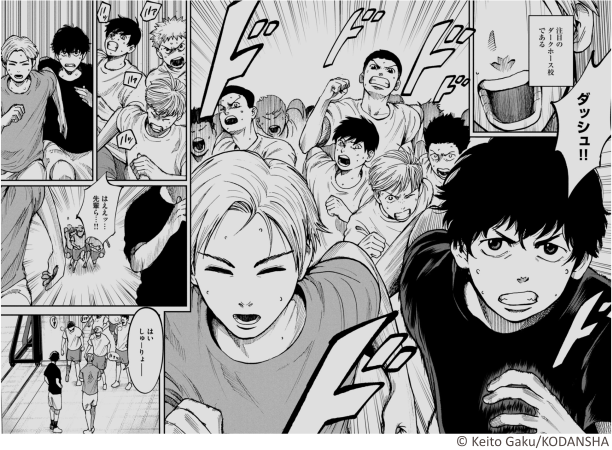
I’m glad that Aoba is just as impatient as I am, and way more daring… or cocky (depends on the view). Unwilling to wait for an entire year or more until he could actually set foot on the indoor court to train ‘properly,’ he challenged (or rather provoked) his team B senpai during a training session. Before the verbal quarrel could get out of hand, Seirai’s coach, Iori Shūsuke, showed up and intervened. He explained to the first-years that team B is way out of their league because they lack what is most crucial for a basketball player: a balanced body. “Strength, speed, stamina, explosive power. In basketball, all kinds of physical skills are required.” The first-years were devastated by the huge gap in skills, except for Aoba. He wasn’t discouraged so easily and rose to this challenge. Luckily, coach Iori likes ‘hungry’ guys who starve for the top. He thus granted Aoba’s wish: a game between team B and team C to earn the right to train on the indoor court. And the stakes were very high. Should the (playing) first-years lose, they wouldn’t be allowed to set foot on the court in the sports hall ever again.
The Game
After Aoba managed to round up four members to share the risk of this undertaking, the game could begin. I was itching to see amazing passes, unexpected steals, and fast breaks, and thus opened volume two with high expectations. And I wasn’t disappointed. The basketball court was the only setting from the first until the last page, and thus, I could focus my undivided attention on the game. Interspersed with explanations of tactical plays, technical terms, and the athletes’ skills, the two teams battled each other as if their lives depended on it. Captivated, I followed tense situations, unexpected turnarounds, and the individual players’ state of mind, when suddenly… I was at the end of the volume! How could this be? And the game hadn’t even ended yet! Maybe the suspenseful anticipation of the players’ next moves had me flipping through the pages too fast. Or did I unintentionally skip a few pages? In any case, the chapters flew by as fast as the ball whooshed across the court, and now I’m forced to wait until August 7, 2023, when volume three will be up for sale. Well… patience is a virtue.

Admittedly, the plot doesn’t progress very far in Aoba no Basuke’s first two volumes. The very short glance into Aoba’s childhood (three pages) at the beginning of the story stages the negative experience that caused him to turn his back on basketball. Thanks to Akehoshi, this is quickly overcome within the first half of volume one. Apart from Aoba’s accidental meeting with the regular players (team A), the rest of the story revolves (more or less) around his challenge to team B and, of course, the game. And yet, that doesn’t mean that ‘nothing’ is happening. Actually, there’s more to it than passes, steals, and dunks. The mangaka also takes us to a dark place where, I’m sure, all of us have been at some point in our lives, regardless of whether we play sports or not.
The Darkness Within Our Hearts
The charm and appeal of Aoba no Basuke aren’t in a fast-paced story (as far as volumes one and two are concerned), but in its detailed focus on the game and the players. One character who’s portrayed in more detail is Aoba’s senpai and team B-team member, Dōgen Natsume. Contrasting these two characters, Gaku-sensei narrates a story of self-doubt and paralyzing fear, but also of determination and ambition.
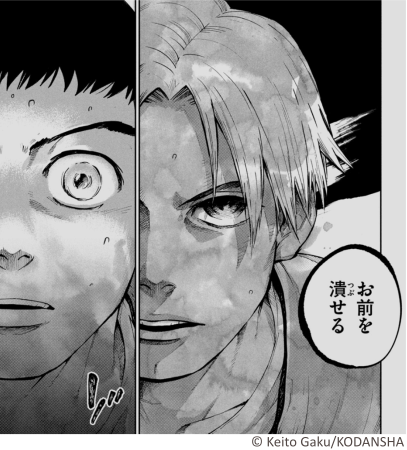
We meet Dōgen Natsume for the first time when Aoba participates in the first training session. He is one of the two second-years responsible for whipping the newbies into shape. It was also Dōgen who was challenged by Aoba, and it’s primarily these two who are pitted against each other in the game for the indoor training participation. As Dōgen goes head-to-head with Aoba, not only do the differences in their physical traits becomes clearly visible but also their distinct mental attitudes. While Aoba’s motivation receives a big boost and his competitiveness is spurred on every time he’s up against a strong(er) opponent, Dōgen seems to be the opposite. The training under an authoritarian and unforgiving coach during middle school instilled in him a paralyzing fear of making mistakes. Additionally, his failure to succeed against a 2m opponent in a previous game crushed his self-confidence completely.
But even the other players, who have not had traumatizing experiences (so far) weren’t immune to the demoralizing whispers that arose from the shadows of their doubts. I recognized this ominous incarnation of self-doubt and resignation immediately. Gripping your shoulder with its oppressive hand, it draws close and whispers words of darkness into your ear. Words that gnaw at your determination and your self-esteem. When I looked at the images, I thought to myself, I know this; I’ve been there. Then again, who hasn’t?

Overcoming
The great thing about sports manga (and anime), and what I also love about these stories, is that the athletes always find a way to deal with such issues, and that they always overcome mental and physical setbacks. Sometimes it’s their intense desire to win that spurs them on, or a clear goal before their eyes that refuels their determination. Other times, it’s the support of friends and teammates that pushes them to move on. Of course, these are fictional stories that lack the complexity of real life. Still, sometimes, a simple, clear-cut advice might give us just the right push we need to take the most difficult but also most crucial step toward a (new) goal: the first one.
Now, what kind of advice does Aoba no Basuke give us? Coach Iori says, “As long as you have victory clearly in your sight, your body will carry you to the desired result.” If you are fearful of what could await you should you dare to take this crucial first step, maybe these words of coach Iori will ease your mind and encourage you: “Give it a try. It’s okay to fail.” By the way, with the depiction of Dōgen’s two coaches, Gaku-sensei also hints at how influential a trainer can be, particularly when you are still an impressionable youngster. He thereby also makes a clear statement against a harsh, authoritarian coaching style.

The Perks Of Being Average
One aspect I really like about the characters in Aoba no Basuke is that they are all ‘average’ teenagers. No one possesses an eagle or emperor eye or has the ability to ‘vanish.’ There are no aliens, hot-headed delinquents, or overly gutsy guys. No obstinate individualists or excessively devoted team players. There’s no family drama that fuels the characters’ motivations, and no love interest that needs to be impressed. This is truly a basketball-focused manga.
And then there is the art style. When the speed lines that make your eyes race across the pages are exchanged for a gritty art style, you’ll involuntarily hold your breath because you can feel that now stuff is going to get intense! Also, Gaku-sensei lets the images in the action scenes speak for themselves and doesn’t overladen them with speech or thought bubbles. Nothing is more annoying than ‘watch-reading’ sports action scenes and having a person’s every single thought thrust visually into your face. One word of advice, though: if you are not very knowledgeable about this sport, but still want to understand all the technical intricacies and tactical decisions of the players, you might want to open a basketball dictionary in your browser while reading, because not all technical terms are explained. Still, if you like gripping (sports) manga, you’ll love Aoba no Basuke, even if you’re not a ‘basuke-baka.’
The conflicts, interpersonal tensions, and athletes’ personal development distracted me from the original premise of the manga, the ‘size’-issue. So, how does this play out in the course of the two volumes?
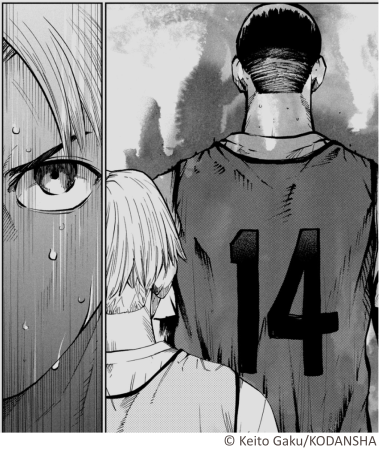
The Downside Of Being Tall
The benefits and drawbacks of both a tall and a short body are mentioned on several occasions. In general, though, tallness seems to be the ‘bad guy.’ Aoba is discriminated against and taken advantage of because he’s tall. Additionally, his worth as a basketball player is repeatedly questioned because of his size: “Don’t tell me your height is the only weapon you have?” Ultimately, height is shown to be irrelevant or even disadvantageous if the athlete has nothing else to show for. (Which is quite logical because height alone doesn’t make a good athlete.) In the end, the discussion about height serves to highlight all the other skills an athlete must possess to have a positive impact on the outcome of a game.
I’m very curious how this will play out in the ongoing game of team B vs. team C. What skill will be the deciding factor? Will Dōgen’s hard work and team B’s technical and physical superiority pay off? Or will Aoba be able to coordinate his play with his teammates and use his excellent vision (and his height) to open the doors to the indoor court?
A Look Into The Future
Gaku-sensei is kind enough to grant us a peek into the story’s future. When Aoba coincidentally encounters team A, two of its members are portrayed as rather quirky—in a funny way, though. This scene is also the only one that offers comic relief. Albeit short, it promises a colorful mix of individual characters who might pose new challenges to Aoba once he manages to secure his spot as a regular. This is most likely going to happen if the double-page spread at the beginning of volume one has any prophetic value.
However, with no clairvoyant powers and no crystal ball at hand, there is no telling how the story will develop or what exciting challenges will await Aoba and the other members on their path forward. Although, based on the first two volumes, the mangaka seems to be in no hurry to race through the story at high speed. This also means that—hopefully—he will give us an abundance of riveting basketball games to watch (and read) to our hearts’ content.
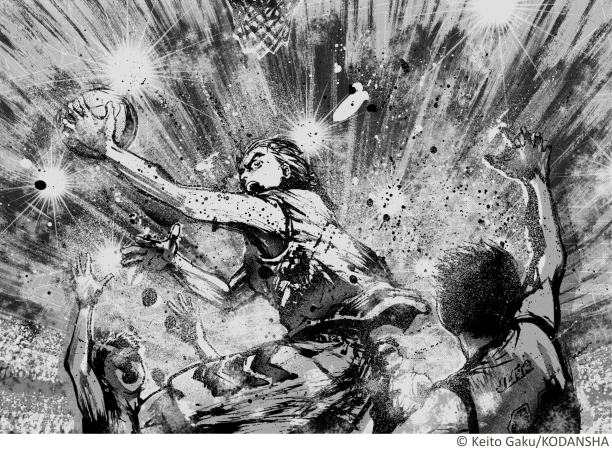
Links:
- Original post published on sportsbaka.substack.com
- Manga Aoba no Basuke
You can watch some of Jokić’s plays here:
Subscribe to never miss a deep dive into the exciting world of sports anime, manga, and manhwa!


